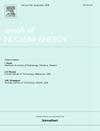Three-dimensional refined burnup characteristics analysis of Helical Cruciform Fuel
IF 1.9
3区 工程技术
Q1 NUCLEAR SCIENCE & TECHNOLOGY
引用次数: 0
Abstract
The Helical Cruciform Fuel (HCF) is an advanced Innovative Fuel Design (IFD) that present greater challenges for three-dimensional(3D) refined burnup characteristic analysis. A burnup region division method for HCF was proposed and the burnup characteristic analysis was conducted using OpenMC code. 3D refined distribution of thermal and fast neutron flux and power density, isotope densities of typical nuclides at different positions of HCF were calculated. The influences of twist pitch, axial enrichment, and boundary conditions were studied. Meanwhile, burnup characteristic on HCF and cylindrical fuel was compared with the same material and volume. The results show that, the chain reaction of HCF can last longer, and has obvious economic advantages than cylinder fuel. Unlike cylindrical fuel, the circumferential distribution of neutron physical variables for HCF is inhomogeneous and becomes more pronounced with burnup. The proposed analysis method is applicable to any specially shaped fuel and effectively predicts the neutron physical properties during burnup, forming the foundation for IFD and safety analysis.
螺旋十字形燃料的三维精炼燃耗特性分析
螺旋十字形燃料(HCF)是一种先进的创新燃料设计(IFD),对三维(3D)精细燃耗特性分析提出了更大的挑战。提出了一种HCF的燃耗区域划分方法,并利用OpenMC代码进行了燃耗特性分析。计算了典型核素在HCF不同位置的热中子通量、快中子通量、功率密度和同位素密度的三维精细分布。研究了扭距、轴向富集、边界条件等因素的影响。同时,比较了相同材料、相同体积下HCF和圆柱形燃料的燃耗特性。结果表明,HCF的链式反应持续时间更长,具有明显的经济优势。与圆柱形燃料不同,HCF的中子物理变量的周向分布是不均匀的,并且随着燃耗的增加而变得更加明显。该分析方法适用于任何特殊形状燃料,能有效地预测燃耗过程中的中子物理性质,为引燃分析和安全性分析奠定基础。
本文章由计算机程序翻译,如有差异,请以英文原文为准。
求助全文
约1分钟内获得全文
求助全文
来源期刊

Annals of Nuclear Energy
工程技术-核科学技术
CiteScore
4.30
自引率
21.10%
发文量
632
审稿时长
7.3 months
期刊介绍:
Annals of Nuclear Energy provides an international medium for the communication of original research, ideas and developments in all areas of the field of nuclear energy science and technology. Its scope embraces nuclear fuel reserves, fuel cycles and cost, materials, processing, system and component technology (fission only), design and optimization, direct conversion of nuclear energy sources, environmental control, reactor physics, heat transfer and fluid dynamics, structural analysis, fuel management, future developments, nuclear fuel and safety, nuclear aerosol, neutron physics, computer technology (both software and hardware), risk assessment, radioactive waste disposal and reactor thermal hydraulics. Papers submitted to Annals need to demonstrate a clear link to nuclear power generation/nuclear engineering. Papers which deal with pure nuclear physics, pure health physics, imaging, or attenuation and shielding properties of concretes and various geological materials are not within the scope of the journal. Also, papers that deal with policy or economics are not within the scope of the journal.
 求助内容:
求助内容: 应助结果提醒方式:
应助结果提醒方式:


